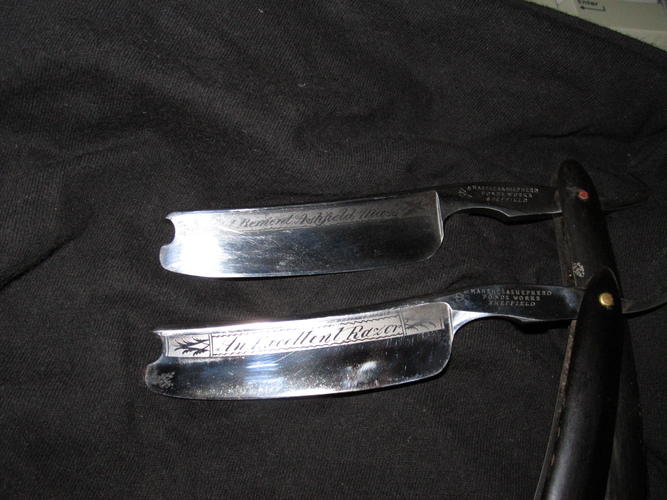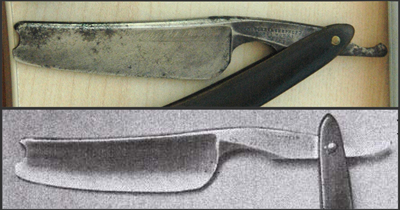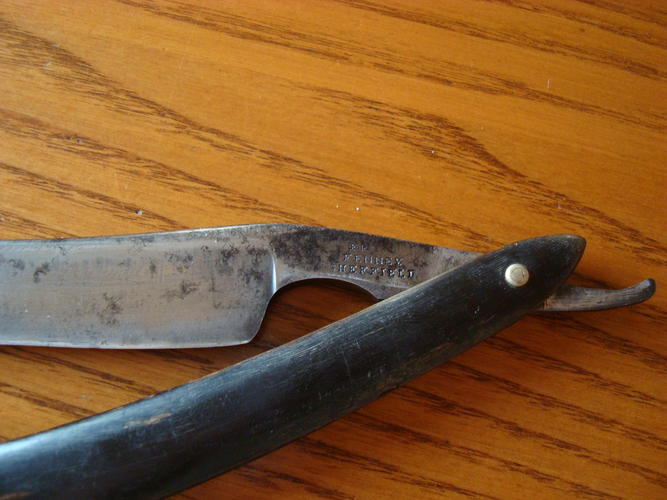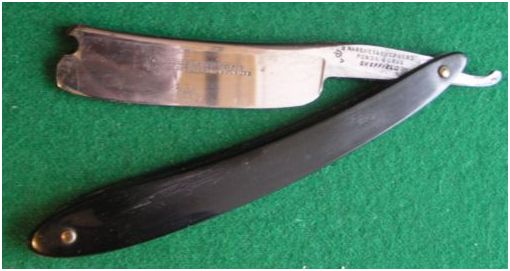Results 21 to 30 of 141
Thread: Tapered blades.
-
03-08-2014, 05:44 PM #21

With the M&S that I have, the spine is tapered so that if I lay it flat (neglecting the slight smile), the back and edge contact along the whole length of the blade. Mine has the etching, so there's no way that it could have been re-polished and still keep the original grind shape. And if the material is simply removed on the edge, the bevel will show it as the razor is thicker as you move toward the spine. I've seen some few regrinds where just material close to the edge was taken off, and that leaves a grind that has 2 parts (ie you can see the shape from the original wheel and a different concave from the regrind). Most of the regrinds I have are along the whole face of the blade, but they are all roughly finished in comparison to factory polish.
-
03-08-2014, 05:52 PM #22

That was my point. I had a new-looking MacDaniel who was sharpened enought to shave arm hairs when I received it, but the edge wasn't in contact when I put it on the stone.
I'm really perplexed about those razors. It looks for me like used razors, and I can't see the point about making new razors this way... And I've never seen any vintage representation of one of those...
But if you say that the blade laying on the stone has the edge and the back perfectly in contact... I'm only waiting for a vintage illustration of it to be perfectly convinced.
I'm only waiting for a vintage illustration of it to be perfectly convinced. 
-
03-08-2014, 06:07 PM #23

An illustration from a vintage advert, or catalog would be nice. At first I too doubted the tapered blade theory but seeing all of Zak's and Science Guy's examples I'm more convinced. As for the traveling grinding wheel man, (great pic BTW) I'm thinking that if the average grinder/craftsman was even barely proficient in his craft the results wouldn't have been such a drastic taper from heel to point. If I gave a razor with edge and spine parallel and received it back from the grinder/craftsman tapered like that I would probably give the guy a black eye.
 Be careful how you treat people on your way up, you may meet them again on your way back down.
Be careful how you treat people on your way up, you may meet them again on your way back down.
-
03-08-2014, 06:09 PM #24

I don't know if any catalogues exist or would be easy to find from that era. I think we can take as good evidence just looking at those etched "An Excellent Razor" (or an etching in a very similar style). Since they are etched it is easy to tell if they were reground or not. And the sheer amount that all look the same (I have never seen "An Excellent Razor" from the period that was actually not tapered, and to have such a relatively large amount of nearly identical M&S razors with the same etching and blade style be misground seems improbable to me).
As far as aesthetics, in the 1700s the blades were tapered in the opposite direction, so I think it's just a matter of a style that took hold for a short time for whatever reason.




-
03-08-2014, 06:11 PM #25
-
03-08-2014, 06:11 PM #26

The paradox I think is that he would have had to be so bad to give all the example razors I have seen such a terrible grind but also have been so good to have perfectly erased all traces of the grinding and allowed for the bevels to be even along the whole thing, also tapering the spine to carefully match the taper in the blade. So I really think only the factory put these out.
-
03-08-2014, 06:55 PM #27Historically Inquisitive



- Join Date
- Aug 2011
- Location
- Upstate New York
- Posts
- 5,782
- Blog Entries
- 1
Thanked: 4249
In all honesty, i must say im not convinced myself. Never ran into any documentation about a tapered blade, or provenance of such a type of razors. And actually some of them just look like they have a slight smile, from unexperienced honing or added on purpose.
I could see how easy it would be to make this razor pictured below look like a tapered blade?
Please note that this razor is from the same period as the tapered blade razor posted in this thread.

-
03-08-2014, 07:19 PM #28

Martin, are there catalog or advertising illustrations for blades from that specific time period extant at all ? If there are the absence of tapered blades might say quite as much as the inclusion.
 Be careful how you treat people on your way up, you may meet them again on your way back down.
Be careful how you treat people on your way up, you may meet them again on your way back down.
-
03-08-2014, 07:47 PM #29

I've been looking for an old document I remembered from Judge Lummus ("Old Sheffield Razors" by Lummus. Antiques, December 1922), and he talked about it in the second paragraph of the first picture as "straightbacks", and the "T" of the second picture is one of those.


I still don't see the point about making razors this way, but I'm beginning to believe it a lil more.
Edit : Well.. I just noticed you talk about Lummus in your Birmingham thread..Last edited by Thaeris; 03-08-2014 at 08:14 PM.
-
The Following User Says Thank You to Thaeris For This Useful Post:
JimmyHAD (03-08-2014)
-
03-08-2014, 08:17 PM #30

Great work Thaeris ! AFAIC that is proof enough for me.
 Be careful how you treat people on your way up, you may meet them again on your way back down.
Be careful how you treat people on your way up, you may meet them again on your way back down.


 343Likes
343Likes LinkBack URL
LinkBack URL About LinkBacks
About LinkBacks







 Reply With Quote
Reply With Quote

